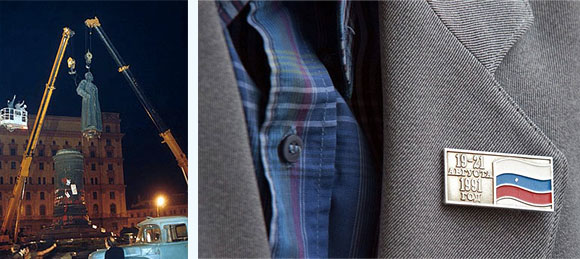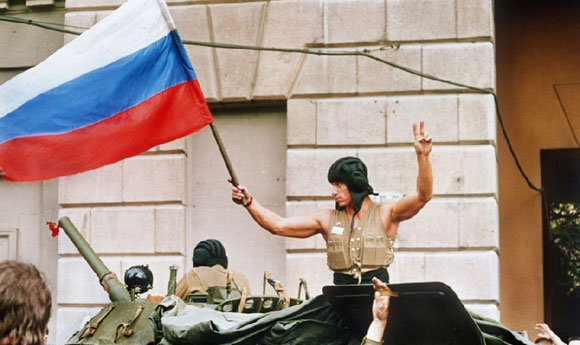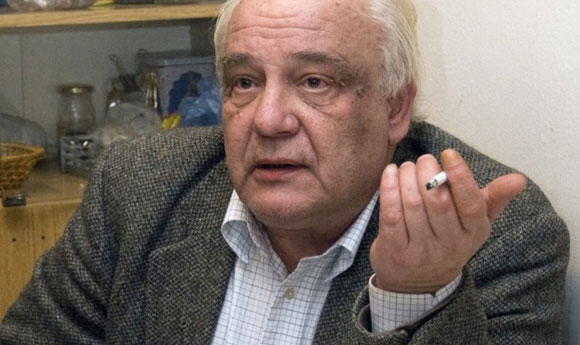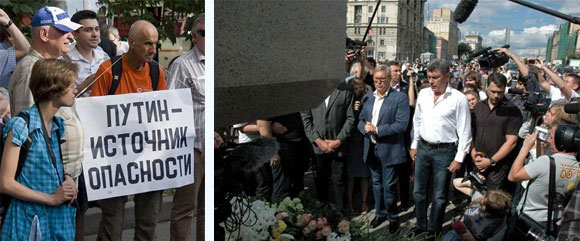The anniversary of the Russian democratic forces' victory over the August 1991 attempted Communist/KGB coup d’état has rekindled a debate on the missed opportunities of the 1990s. Just eight years after the August revolution the putsch organizers’ ideological heirs managed to return to power. Political commentator and historian Vladimir V. Kara-Murza discusses the reasons for the pro-democracy leaders’ post-1991 failure, and the importance of historical lessons for Russia’s present-day opposition.

On August 19 2012, a note reading "Forgive us for being unworthy of your sacrifice" was left at the memorial to Dmitri Komar, Ilya Krichevsky, and Vladimir Usov, defenders of the Moscow White House slain during the attempted August 1991 coup d’état. Twenty-one years ago, it seemed all Moscow had turned up for their funeral. At the ceremony, president Boris Yeltsin publicly apologized to the young men’s parents for “not being able to protect” them. Every August, a wreath from Russia’s president was laid at their memorial. This tradition was abandoned in the early 2000s by the new president. The same leader that invited the 1991 coup leader Vladimir Kryuchkov to his presidential inauguration, reinstated the Stalinist national anthem, and declared the peaceful dissolution of the Soviet empire to be “the century’s greatest geopolitical catastrophe.” It is hardly surprising that Russia’s current regime ignores the August 1991 anniversary—the anniversary of a free people’s victory over totalitarianism.
The official silence, however, does not mean that this date has been forgotten. On August 19, as in previous years, hundreds of Muscovites laid flowers at the memorial. Near the White House, the Republican Party of Russia–People’s Freedom Party and the Yabloko party, with participation of the Solidarity movement and several human rights groups, organized a “rally of memory and hope.” The rally’s participants, either former White House defenders or present-day opposition leaders (or, in Boris Nemtsov’s case, both) asserted that Russia is being ruled by the coup’s ideological heirs who have not only destroyed the August revolution’s gains but have followed almost to the letter the plotters’ Decree # 1, which envisaged “taking control of the media,” “suspending political parties, social organizations, and mass movements,” and banning “rallies, street processions, and demonstrations.”

Moscow. August 21, 1991.
Twenty-one years ago, Russia awoke to the sounds of Swan Lake. The streets of Moscow were filled with armored vehicles. Pale-faced television presenters read Soviet Vice President Gennady Yanaev’s decree, which began “Due to the ailing Mikhail Sergeevich Gorbachev’s inability to fulfill his duties…” The self-proclaimed “State Committee on the State of Emergency,” known by its Russian acronym, GKChP, included leaders of the Communist Party, the KGB, and the Soviet Government.
Along with restricting constitutional rights and introducing media censorship, the putsch organizers declared a state of emergency and ordered local authorities to report to GKChP commandants. By a separate decree, the coup leaders cut off the Russian television and radio transmissions, which had been under the jurisdiction of the republic’s president, Boris Yeltsin, as well as transmission of the Ekho Moskvy independent radio station.
The plotters commanded the full might of the Soviet government, the KGB, the army, and all national media outlets. There was just one element they failed to take into account: the Russian people who, tired after decades of lies and powerlessness, did not want a return to the Soviet past and were prepared to defend their dignity. During those three days, hundreds of thousands of residents of Moscow, Leningrad, Sverdlovsk and other cities answered Alexander Galich’s famous call: “Can you come to the square / Dare you come to the square / When that hour strikes?”
On August 19, hundreds of Muscovites began erecting makeshift barricades in front of the White House. The next day, the crowd there swelled to 200,000 people. Moscow residents were unafraid of the tanks, the curfew, or the White House attack planned by coup leaders for the night of August 20 (the night Komar, Krichevsky, and Usov were killed in a tunnel under Novyi Arbat street during armored vehicle maneuvers by the Taman division still loyal to the GKChP).
It was rumored that KGB Chairman Vladimir Kryuchkov refused to believe the reports and demanded to be driven to the White House to see for himself that Moscow’s streets really were filled with people. The special “Alpha” unit disobeyed the order to attack the White House, and the Tula amphibious division’s Ryazan regiment openly joined ranks with the White House defenders. By the morning of August 21, it was all over. Unarmed citizens on the streets of Moscow proved to be more powerful than the entire Soviet state apparatus.
Dismantling the vanquished system’s vestiges didn't take long. On August 22, thousands of Muscovites gathered on Lubyanka Square near KGB headquarters and pulled down the statue of its founder, Felix Dzerzhinsky—the high-profile symbol of a once-powerful, repressive machine. On the same day, President Yeltsin signed a decree replacing the Russian Soviet Federative Socialist Republic’s red flag with Russia’s historic white-blue-and-red tricolor. With another decree on August 23, Yeltsin officially suspended the Communist Party (it was banned altogether on November 6). The Soviet Union itself ceased to exist before year’s end: on December 25, the redundant red flag was lowered over the Kremlin for the last time.
Not one among the thousands in Lubyanka Square that evening celebrating victory over the putschists and chanting “Down with the KGB” could have imagined that in just eight years, resistance leader Boris Yeltsin would hand the keys to the Kremlin to a former officer of the Soviet secret police. Experts have dedicated volumes to analyzing the reasons that forced Russia’s first president to choose such a successor. Few mention that Russia’s democratic government committed the fatal mistake that ultimately led to the 1999-2004 authoritarian restoration soon after the August 1991 victory.
The Russian democratic movement’s most farsighted leaders warned against an impending danger from the start. “Let us not celebrate prematurely: the dragon is not yet dead. It has been mortally wounded, its back has been broken, but it still holds human souls in its clinging claws,” declared legendary Soviet dissident Vladimir Bukovsky at an early September 1991 rally in Moscow’s Mayakovsky Square. “The Lubyanka [KGB] archives seized by the Russian government contain the secrets of terrible crimes. Only by opening these archives, by allowing an objective international commission to study them, can we cleanse ourselves of this filth.”
Having dismantled the Communist/KGB system, the new Russian government had to protect the young democracy from its possible resurgence. As in Czechoslovakia, the Baltic States, and the former East Germany, measures had to include opening of archives, official recognition of the regime crimes, and lustration of former party and secret police officials involved in regime's crimes. Helping society come to terms with its history and undergo a moral transformation is the best bulwark against repeating past misdeeds, as shown by de-Nazification of post-war Germany.

Vladimir Bukovsky, a leading member of the dissident movement of the 1960s and 1970s, writer, neurophysiologist, and political activist.
“It was a unique moment. Everything was possible,” recalled Bukovsky in his book Judgment in Moscow. “Afraid of lynching and mob justice, the disoriented nomenklatura (the Soviet ruling class) would have agreed to anything. They were still catching their breath after seeing ‘Iron Felix’ [Dzerzhinsky] dangling from a steel noose. In this situation, it would have been possible to conduct, if not a Nuremberg-style trial, then something very similar. And the potential moral impact on our barbaric world might have been even greater.”
Russia's transformation was at least as realistic as that of the Central European countries. According to a 1992 VTsIOM poll, 54 percent of Russians wanted to “remove former Communist Party members from important [state] positions.” The groundwork was laid early. On September 11, 1991, Vladimir Bukovsky and Russian Government Archive Committee chairman Rudolf Pikhoya signed an agreement “On an international commission to study the activities of [Communist] party and state security forces in the USSR.” The commission was to include research organizations from Russia (the Memorial Center, the Humanitarian University) and the West (the International Council on Archives, the Hoover Institution, and others). On October 18, President Yeltsin signed the law “On the Rehabilitation of the Victims of Political Repression” which not only recognized the “decades-long terror and mass persecutions of their own people” carried out by the Communist regime, but also introduced a measure of lustration. Article 18 provided that “the operatives of the VChK, GPU-OGPU, UNKVD-NKVD, MGB [all acronyms for the KGB], prosecutors, judges, members of commissions, special councils, dvoikas, troikas [of the NKVD], or operatives of other agencies with judicial powers, and judges who participated in enquiries or considered political repression cases, are held criminally responsible under the current law. Information on those found responsible, by due process, of falsifying cases, using illegal enquiry methods, and/or committing human rights crimes, will be regularly published in the press.”
The Communist system's criminal nature was, ironically, confirmed by those same Communists' appeal to the Constitutional Court, challenging the presidential ban on their party. During the hearings, Bukovsky, a court expert for President Yeltsin’s side, got access to thousands of classified Communist Party Central Committee documents, many of which are now published in his online archive. In Ordinance 9-P, issued November 30, 1992, Russia’s highest judicial authority acknowledged that “the governing apparatus of the Communist Party of the Soviet Union was the initiator, and local apparatuses often the conductors, of policies of repression directed at millions of Soviets, including deported nationalities. This continued for decades.” In December 1992, Galina Starovoitova, a prominent Russian legislator, introduced a bill “On Lustration (A Temporary Political Ban on Persons Who Implemented the Totalitarian Regime’s Policies).” The legislation envisaged a five to ten year prohibition on former local and regional committee secretaries, employees of the Communist Party’s central committees, or “staff, including reserve employees or those who collaborated with the NKVD-MGB-KGB” from holding executive office.
That by the end of the 1990s, Russia had to choose between Primakov and Putin is the best testimony to the missed opportunities of August 1991.
But this unique opportunity was wasted. The idea of an international commission to study Communist Party and KGB crimes was quickly abandoned. Archives resealed their doors as soon as the Constitutional Court hearings were over. The bill on lustrations was never considered. According to Bukovsky, the principal opposition to further de-communization came from the president himself. For one thing, Yeltsin’s past was inextricably linked with the Communist Party, though as someone who resigned from the party in 1990 and led the anticommunist revolution in 1991 he would surely have been exempt from any ban. Just as important, though, the Russian president was under pressure from Western politicians fearful their own Kremlin ties would come to light. Finnish Prime Minister Kalevi Sorsa’s defeat in the 1993 Social Democratic presidential primaries was attributed at least in part to the publication of minutes of a Soviet Communist Party Central Committee meeting describing him as a “trusted collaborator.” In public, the refusal to put the Communist/KGB regime on trial and introduce lustrations was explained by the need to keep “experienced professionals” in government. Some were unwilling to conduct "a witch-hunt." “Be careful," Bukovsky warned as he left Moscow in 1993. "This is like dealing with a wounded beast: if you don't finish it off, it will attack you”.
This prediction came true in 1999, although the botched policy’s repercussions became apparent much sooner. In 1995, the Communists (who, unlike their counterparts in Central Europe, remained not only unreformed but openly nostalgic for Stalin) became Russia’s largest parliamentary party. In 1996, they presented the main alternative to Yeltsin in the presidential election. Following the 1998 financial crisis, the “red” parliament forced Yeltsin to appoint a pro-Communist cabinet led by former KGB Deputy Chairman Yevgeny Primakov and former USSR State Planning Committee Chairman Yuri Maslyukov. Meanwhile, "experienced KGB professionals" successfully climbed the career ladder within the executive branch. The rise of Vladimir Putin, who in a mere three years between 1996 and 1999 went from deputy manager of presidential properties to Secretary of the Security Council, was a case in point. That by the end of the 1990s, Russia had to choose between Primakov and Putin is the best testimony to the missed opportunities of August 1991.

Moscow. August 19, 2012.
Analyzing the mistakes of two decades ago is not only important for historians. Recent events—a political maturing of the middle class, the mass opposition protests reminiscent of the rallies of 1990-1991, and a precipitous fall in support for the current regime—suggest that history may be giving Russia another chance at freeing itself from authoritarian yoke. If this opportunity is not to be squandered, the same mistakes must be avoided. A future Russian administration must conduct a thorough judicial and political assessment of the Putin regime and its collaborators, as well as the KGB's "experienced professionals" who fit in so well under Putin.
As Vladimir Bukovsky emphasized in the early 1990s, this process has nothing to do with “revenge.” It does not involve mass prosecutions of former collaborators. “There was no clear line between a party member and a nonpartisan, between a stoolpigeon and a mere Soviet conformist,” he wrote in Judgment in Moscow. “And how do you deal with that? Create a new Gulag? (…) The aim was… a moral cleansing of society. Not mass hysteria, reprisals, denunciations or suicides… but repentance. For this, it was necessary to try the [entire] system for its crimes, and it would have been sufficient to convict its leaders.” Bukovsky, now one of the leaders of Solidarity, will no doubt give the same advice to Russia’s post-Putin government. It is imperative that, this time, his advice be heeded.

